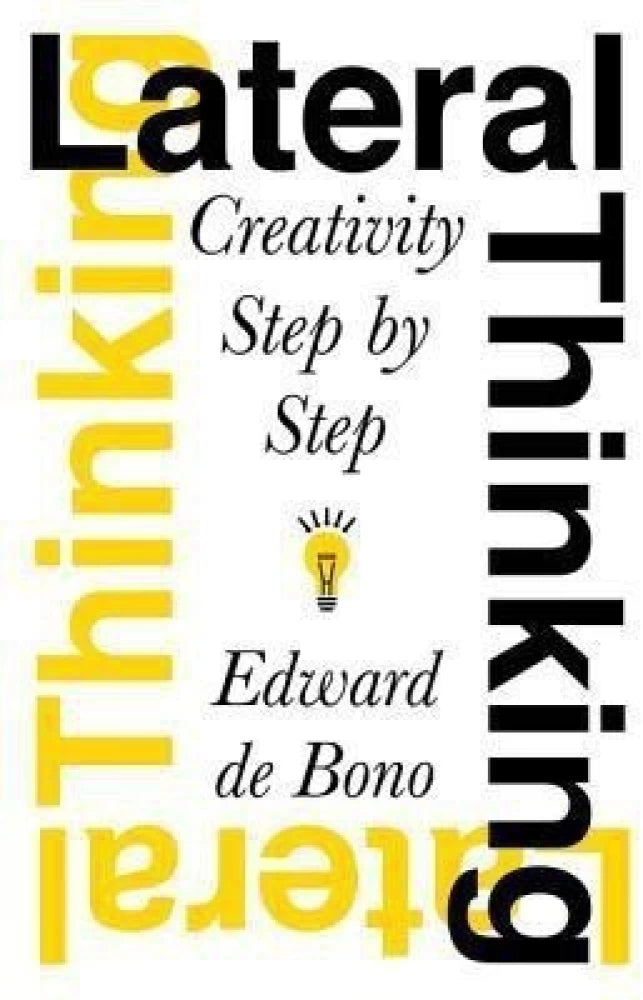Book Summary:
Lateral Thinking: Creativity Step by Step by Edward De Bono is a groundbreaking book that explores the concept of lateral thinking, a term coined by the author himself. Lateral thinking refers to solving problems through an indirect and creative approach, using reasoning that is not immediately obvious and that typically involves ideas that may not be obtainable through traditional step-by-step logic.
De Bono argues that our typical way of thinking—relying on vertical, logical, and linear thought processes—is limiting. To unlock new and innovative ideas, we need to embrace lateral thinking, which involves looking at problems from new angles and challenging conventional thought patterns.
The book is structured as a guide to understanding and applying lateral thinking techniques. It offers practical tools and exercises for training the mind to think in more creative, unconventional ways.
Key Concepts from Lateral Thinking include:
-
What is Lateral Thinking?: Lateral thinking is different from traditional (vertical) thinking, which focuses on logical reasoning and sequential steps. Instead, lateral thinking encourages the generation of ideas through random, creative, and unconventional approaches. It’s about breaking away from the usual thought patterns to explore new possibilities.
-
Techniques for Lateral Thinking: De Bono introduces various techniques to foster lateral thinking, including:
-
Provocation: Challenging existing assumptions by making deliberately provocative statements or questions.
-
Random Entry: Introducing a random element (e.g., an object or word) into the problem-solving process to trigger new ways of thinking.
-
Challenge: Questioning established rules and assumptions in order to generate alternative solutions.
-
Concept Fan: Expanding the thinking process by exploring a wider range of ideas or possibilities in response to a given problem.
-
-
Breaking Free from Conventional Thinking: The book encourages readers to step outside of traditional boundaries and not to rely on patterns of thinking that have worked in the past. De Bono suggests exercises to help individuals free themselves from mental blocks and embrace new, creative ways of solving problems.
-
Practical Applications: De Bono provides real-world examples of lateral thinking in action, showing how this technique can be used in various fields like business, education, and personal development. He demonstrates how individuals and organizations can harness lateral thinking to solve complex problems, innovate, and foster creativity.
-
The Importance of Creativity: Lateral thinking is presented as an essential skill for solving complex problems in both personal and professional contexts. The book emphasizes that creative problem-solving is not about having "flashes of genius," but rather about systematically applying new techniques to approach challenges in unexpected ways.
Through a series of exercises and challenges, Lateral Thinking provides readers with the tools to think more creatively and break free from the limitations of conventional thinking. It promotes an idea-driven approach to problem-solving that fosters innovation and encourages thinking "outside the box."
Edward De Bono (1933–2021) was a renowned psychologist, author, and thought leader in the field of creative thinking and problem-solving. He is best known for his work on lateral thinking, a concept he introduced in the early 1960s. De Bono was a pioneer in the study of creativity and how individuals and organizations can improve their problem-solving abilities through unconventional methods.
He wrote numerous books on thinking, creativity, and innovation, with Lateral Thinking being one of his most influential works. In addition to his work on lateral thinking, De Bono developed several other techniques, such as Six Thinking Hats, which helps groups think more effectively by approaching a problem from six different perspectives.
De Bono’s contributions to education, business, and personal development have made him a leading authority in creative thinking. His books have been translated into many languages, and his ideas have been widely adopted in a variety of fields. His approach to thinking creatively has been instrumental in helping individuals and organizations navigate complex challenges and discover new opportunities.








![The quest for paradise- the return to the kingdom of fantasy by Geronimo Stilton [hardcover]](http://bestofusedbooks.com/cdn/shop/products/TheQuestForParadise.jpg?v=1627242311&width=533)
![The dragon prophecy [hardcover] by Geronimo Stilton](http://bestofusedbooks.com/cdn/shop/products/TheDragonProphecy.jpg?v=1627240119&width=533)


